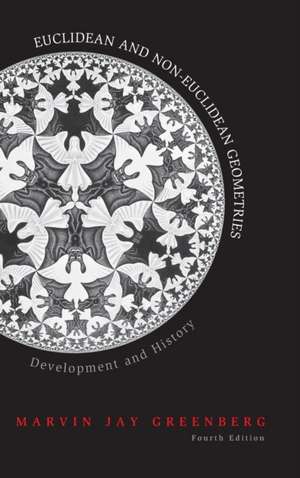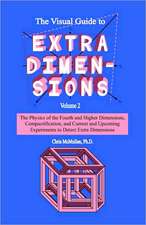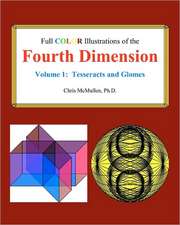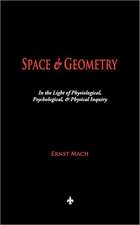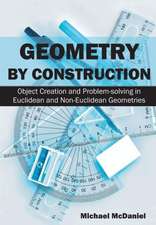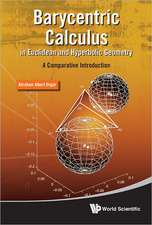Euclidean and Non-Euclidean Geometries: Development and History
Autor Marvin Jay Greenbergen Limba Engleză Hardback – 31 aug 2007
This is the definitive presentation of the history, development and philosophical significance of non-Euclidean geometry as well as of the rigorous foundations for it and for elementary Euclidean geometry, essentially according to Hilbert. Appropriate for liberal arts students, prospective high school teachers, math. majors, and even bright high school students. The first eight chapters are mostly accessible to any educated reader; the last two chapters and the two appendices contain more advanced material, such as the classification of motions, hyperbolic trigonometry, hyperbolic constructions, classification of Hilbert planes and an introduction to Riemannian geometry.
Preț: 1493.95 lei
Preț vechi: 1641.71 lei
-9% Nou
285.96€ • 310.72$ • 240.36£
Carte disponibilă
Livrare economică 31 martie-14 aprilie
Specificații
ISBN-10: 0716799480
Pagini: 637
Ilustrații: 359 illustrations
Dimensiuni: 163 x 236 x 36 mm
Greutate: 1.09 kg
Ediția:Revizuită
Editura: W. H. Freeman and Company
Locul publicării:New York, United States
Public țintă
Academic/professional/technical: Undergraduate. Academic/professional/technical: Postgraduate. Academic/professional/technical: Research and professionalCuprins
Chapter 1 Euclid's Geometry Very Brief Survey of the Beginnings of Geometry The Pythagoreans Plato Euclid of Alexandria The Axiomatic Method Undefined Terms Euclid's First Four Postulates The Parallel Postulate Attempts to Prove the Parallel Postulate The Danger in Diagrams The Power of Diagrams Straightedge-and-Compass Constructions, Briefly Descartes' Analytic Geometry and Broader Idea of Constructions Briefly on the Number ð Conclusion
Chapter 2 Logic and Incidence Geometry Elementary Logic Theorems and Proofs RAA Proofs Negation Quantifiers Implication Law of Excluded Middle and Proof by Cases Brief Historical Remarks Incidence Geometry Models Consistency Isomorphism of Models Projective and Affine Planes Brief History of Real Projective Geometry Conclusion
Chapter 3 Hilbert's Axioms Flaws in Euclid Axioms of Betweenness Axioms of Congruence Axioms of Continuity Hilbert's Euclidean Axiom of Parallelism Conclusion
Chapter 4 Neutral Geometry Geometry without a Parallel Axiom Alternate Interior Angle Theorem Exterior Angle Theorem Measure of Angles and Segments Equivalence of Euclidean Parallel Postulates Saccheri and Lambert Quadrilaterals Angle Sum of a Triangle Conclusion
Chapter 5 History of the Parallel Postulate Review Proclus Equidistance Wallis Saccheri Clairaut's Axiom and Proclus' Theorem Legendre Lambert and Taurinus Farkas Bolyai
Chapter 6 The Discovery of Non-Euclidean Geometry János Bolyai Gauss Lobachevsky Subsequent Developments Non-Euclidean Hilbert Planes The Defect Similar Triangles Parallels Which Admit a Common Perpendicular Limiting Parallel Rays, Hyperbolic Planes Classification of Parallels Strange New Universe?
Chapter 7 Independence of the Parallel Postulate Consistency of Hyperbolic Geometry Beltrami's Interpretation The Beltrami-Klein Model The Poincaré Models Perpendicularity in the Beltrami-Klein Model A Model of the Hyperbolic Plane from Physics Inversion in Circles, Poincaré Congruence The Projective Nature of the Beltrami-Klein Model Conclusion
Chapter 8 Philosophical Implications, Fruitful Applications What Is the Geometry of Physical Space? What Is Mathematics About? The Controversy about the Foundations of Mathematics The Meaning The Fruitfulness of Hyperbolic Geometry for Other Branches of Mathematics, Cosmology, and Art
Chapter 9 Geometric Transformations Klein's Erlanger Programme Groups Applications to Geometric Problems Motions and Similarities Reflections Rotations Translations Half-Turns
Ideal Points in the Hyperbolic Plane Parallel Displacements Glides Classification of Motions Automorphisms of the Cartesian Model Motions in the Poincaré Model Congruence Described by Motions Symmetry
Chapter 10 Further Results in Real Hyperbolic Geometry Area and Defect The Angle of Parallelism Cycles The Curvature of the Hyperbolic Plane Hyperbolic Trigonometry Circumference and Area of a Circle Saccheri and Lambert Quadrilaterals Coordinates in the Real Hyperbolic Plane The Circumscribed Cycle of a Triangle Bolyai's Constructions in the Hyperbolic Plane
Appendix A Appendix B Axioms Bibliography Symbols Name Index Subject Index
Notă biografică
Caracteristici
2 Gives students a historical context of the development of the subject
3 Review exercises reinforce learning throughout
Caracteristici noi
• Balanced Historical Coverage - greater balance is provided between Greek and other cultures including: Egyptian, Babylonian, Hindu and Chinese mathematicians.
• Increased coverage of key events and contributors throughout history - including additional information on the Pythagoreans,
Plato and Euclid.
• Revised coverage of Models, Isomorphism of Models, Axioms of Betweenness, Axioms of Congruence, Geometry without a Parallel Axiom, Measures of Angles and Segments, and Angle Sum of a Triangle, and Parallel which admit a Common Perpendicular.
• A new section has been added to discuss pi, as well as sections on: Straightedge and Compass; Constructions; Brief Historical Remarks; Consistency; Brief History of Real Projective Geometry; Equidistance; Beltrami's Interpretation; Fruitfulness of Hyperbolic
Geometry for Other Branches of Mathematics, Cosmology, and Art.
• More than 50% additional projects, plus new exercises included in every chapter.
